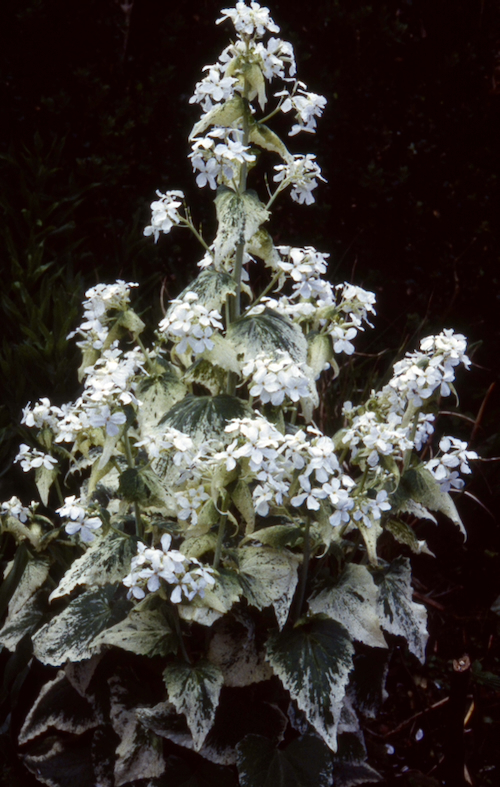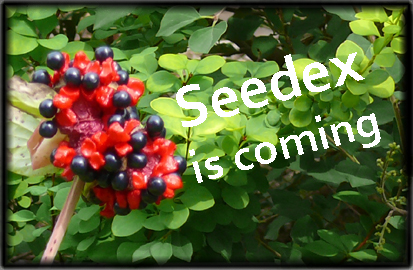
Plant of the Month - April 2023
GENERAL INFORMATION:
I was in my late teens when I first met Summer Snowflake, Leucojum aestivum, in a neighbouring English garden. They were like a snowdrop plant on steroids with tall, glossy mid to dark green leaves and a few dangling “snowdrops”. The flowers differed from Galanthus as their tepals were of equal length. I grew this later in Canada, more of a curiosity. Then I saw delicate, pink-flowered, thin-leafed Leucojum autumnale, the Autumn Snowflake. Unfortunately it is not reliably hardy in Toronto. I am happily growing Leucojum vernum, the best of these three species. It is short, with a fuller inflorescence and blooming as the snowdrops are finishing.
The Autumn Snowflake has grass-like leaves, a solid flower stem and is without markings on the tepals. It was eventually, after much publication, changed in 2004 to the genus Acis with 8 other Leucojum species with similar characteristics. The Spring and Summer Snowflakes are now the only two members of the genus Leucojum.
Common Name: Spring Snowflake, Snowbell, Dewdrop, St. Agnes Flower.
Synonym: Galanthus vernus.
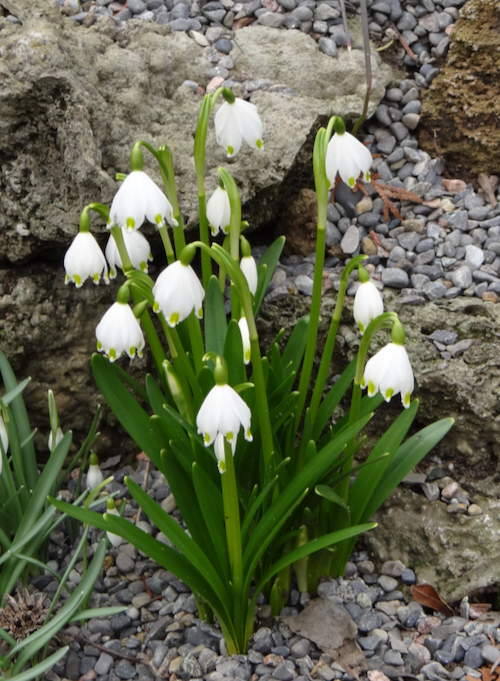
Leucojum vernum.
Varieties:
Leucojum vernum var. carpathicum - with yellow tipped sepals.
Leucojum vernum var. vernum.
Leucojum vernum var. vagner - more vigorous, earlier, with 2 flowers per steak. Comes true from seed.
Cultivars:
Many - different sizes, with single, 2 or even 3 flowers per stem.
Tepal colours from white to yellowish or greenish, single or double.
Green or yellow marks of varying size.
Blooming time varies with cultivars.
Difficult to find and may not be as advertised.
Life Cycle: Clump-forming bulbous perennial, dormant in summer.
Height: 10 to 25 cm when flowering.
Bloom Time: Early April to May in Toronto.
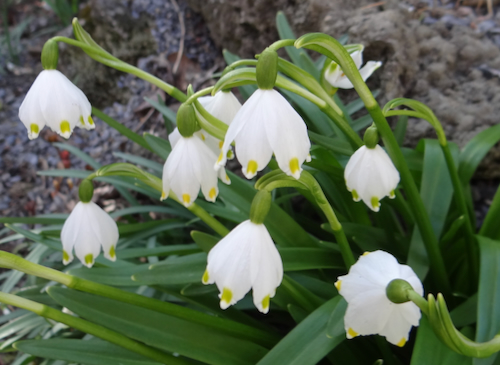
Leucojum vernum - close up of flowers.
Flower Colour & Size: The down-hanging flowers are usually solitary. Six white tepals form a cup-shaped bell and are 15-20 cm long, with a green to yellow mark just before their tips, like a finger nail.
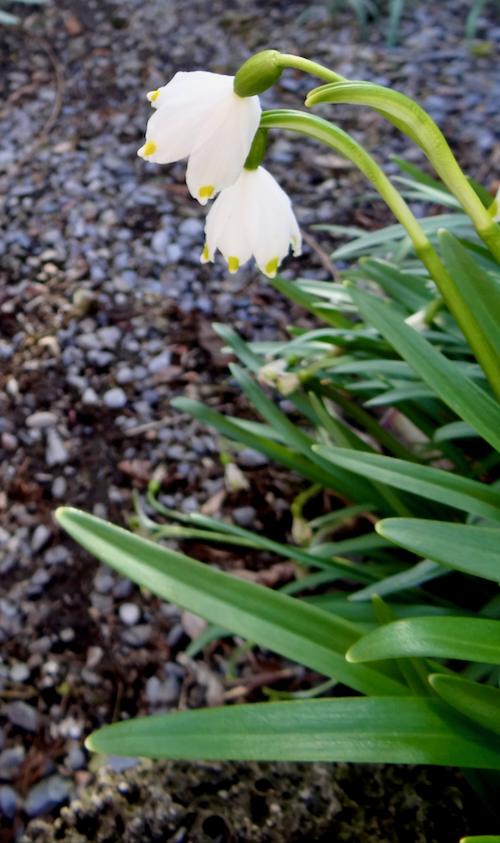
Leucojum vernum - Flowers and Leaves.
Leaves: Shiny, 10-15 mm wide and 10-20 cm long.
Native Range: Central and southern Europe, east to the Ukraine.
Habitat: Damp shady areas.
CULTIVATION: Easy.
Plant: Dry bulbs in the fall, 8-10 cm deep and the same distance apart.
Naturalize: Drifts in lawns.
Light: Full sun to part shade, or open deciduous woodland.
Soil: Most humus rich soils. Prefers to be slightly alkaline.
Water: Average moisture, not very dry or waterlogged.
USDA Hardiness: Zones 4 - 8.
Companion planting: Other spring bulbs with yellow and/or blue colours, rock garden plants, in lawns.
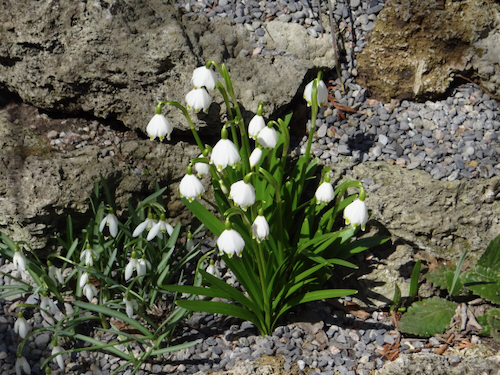
Leucojum vernum in Tufa Bed with Galanthus nivalis and Haberlea rhodopensis.
Propagation: Divide clumps after leaves die down or in the fall. From seed: sow immediately when ripe. Keep @ 20°C for 3 months, then place @ 4°C for 3 months. Seedlings will appear the following year.
Problems: No serious problems, occasional slug damage.
References:
https://en.wikipedia.org/wiki/Leucojum_vernum
https://onrockgarden.com/index.php/germination-guide
Text and images supplied by Anna Leggatt (Toronto Master Gardener)

Plant of the Month - March, 2023
GENERAL INFORMATION:
We eagerly look for signs of spring in early March. A few flowers are in bloom or are showing colour. Many species Crocus, or Snow Crocus, and their cultivars, are starting to emerge, even through the snow. Some are coloured lilac or purple, adding to the whites and yellows of the earliest spring bulbs and corms.
Crocus tommasinianus is one of the first of these. I planted the species many years ago and they have spread around the garden. C. t. ‘Whitewell Purple’ made a lovely purple accent among these and other bulbs. C. t. ‘Ruby Giant’ was added later. These have crossed. I now have a mixed population with a few of the original cultivars.
Common Name: Snow Crocus, Early Crocus, Lilac Tommy, Botanical Crocus
Environmental Benefits: Food early in the season for pollinators.
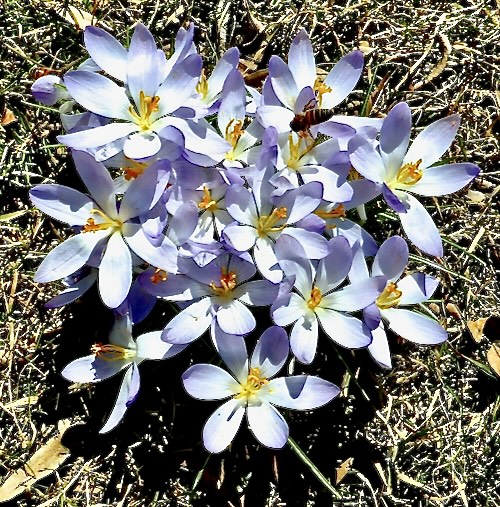
Crocus tommasinianus with Honey Bee.
Cultivars:
Crocus tommasinianus ‘Albus’ - pure white with orange anthers and stigmas.
‘Barr’s Purple’ dark purple with a silvery sheen on the outside of the tepals.
‘Lilac Beauty’ pale lilac, more white in centre, pale outside.
‘Roseus’ has 2-tone pinkish flowers.
‘Ruby Giant’ larger, deeper purple.
‘Whitewell Purple’ Slender purple tepals, silvery inside.
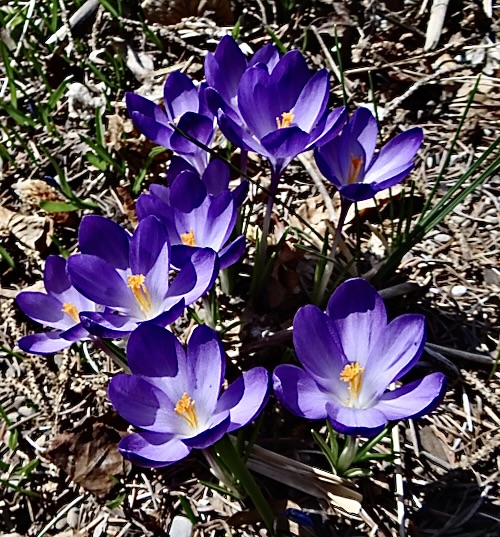
Crocus tommasinianus ‘Whitewell Purple’
N.B. Caution - not all corms for sale are as advertised.
Life Cycle: Perennial corm, summer dormant.
Height: to 12 cm high, clumps spreading to 15 cm wide.
Bloom Time: end of March - April in Toronto.

Crocus tommasinianus - Flower structure.
Flower Colour & Size: Several flowers grow from each corm.These are long white tubed inflorescences with 6 spatulate tepals, about 3 cm in length. They form a goblet to starry shape in shades of lavender with a central white throat The anthers are orange or yellow and stigmas orange. Flowers close at night and on dull days.
Leaves: 3-5 linear leaves, faintly silver striped, short lasting, appearing with the flowers.
Range: Southern Hungary and Balkans.
Habitat: Hillsides and woods.
CULTIVATION:
Plant: Place where the flowers can easily be seen from the house. Plant corms in drifts in the fall, 8-10 cm deep, 8-10 cm apart. Firm soil to deter rodents.
Naturalize: In groups in lawns. Mow when leaves die down, about 6 weeks after flowering. Self-seeds and is also spread by rodents.
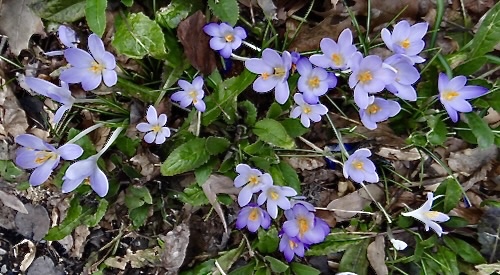
Crocus tommasinianus - self seeding forms.
Light: Deciduous shade to full sun.
Soil: Average, well drained soil. Avoid planting in clay soils.
Water: Medium moisture.
USDA Hardiness: Zones 3 - 8
Companion planting: Grass, other spring bulbs, spring blooming small shrubs.
Propagation: Divide clumps after leaves die down or in fall and replant. From seed: best sown outside in the fall. Seeds need fluctuating temperatures, with freezing for about 3 months. Leave in a pot for 2 years.
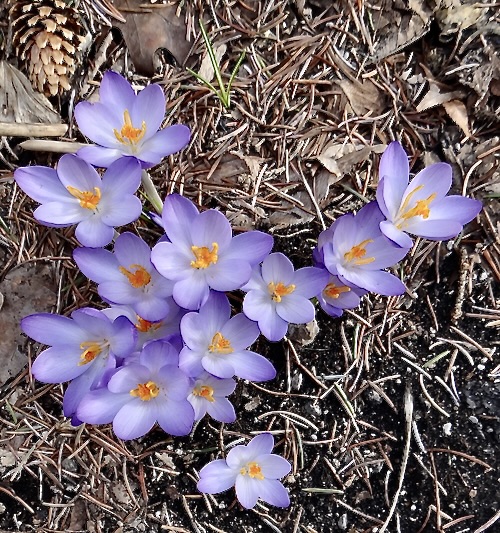
Crocus tommasinianus - Divided clump.
Problems: Rodents may dig up corms but seem to prefer other crocus. Deer and Black Walnut resistant.
References:
https://www.missouribotanicalgarden.org/PlantFinder
https://onrockgarden.com/index.php/germination-guide
Text and images supplied by Anna Leggatt (Toronto Master Gardener)

Plant of the Month - February 2023
GENERAL INFORMATION:
The original specimen was discovered growing in Eastern Oregon in the Wallowa Mountains. It was named after Chief Joseph who led the Nez Perce Nation in the late 1800s.
Winter days seem long and dreary at the end of January, especially if the snow has melted. This is when evergreens give great interest to the garden, with greens ranging from purplish-black to dark and light greens. Many are in shades of blue or have yellow or white splashes. Pinus contorta var. latifolia ‘Chief Joseph’ is my all time favourite winter tree as the cold turns its green needles to a glowing gold. This is the most eye-catching tree in my February garden.
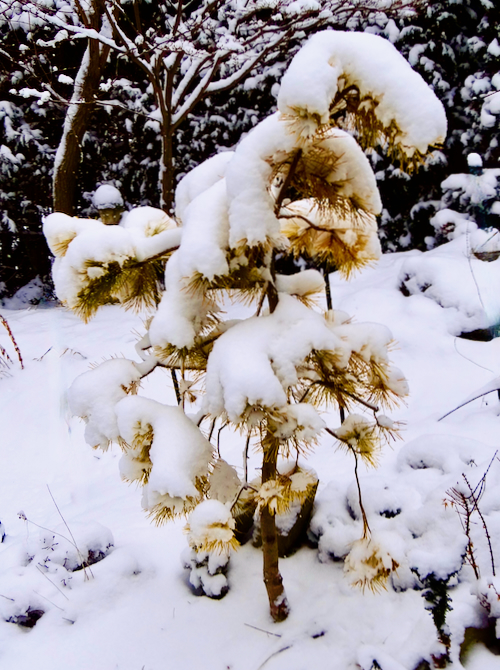
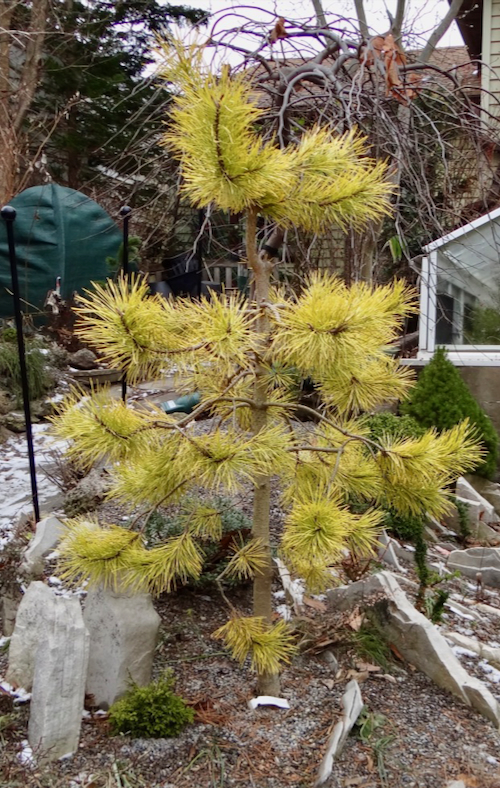
Pinus 'Chief Joseph' mid January. P. 'Chief Joseph' February.
Common Name: Golden Lodgepole Pine or Beach Pine
Life Cycle: Evergreen dwarf coniferous tree.
Height: to 3 m, spreading to 2 m in 10 years.
Flower: Non-flowering. Cones on a mature specimens.
Leaves: Needles are a greenish yellow in summer, becoming a wonderful golden yellow in the winter cold. They are stiff, 9 cm long, 2 mm wide, with two in each bundle.
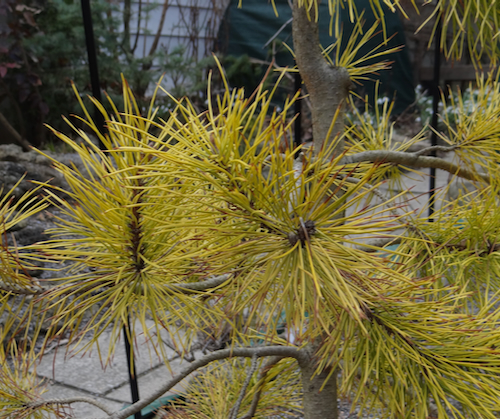
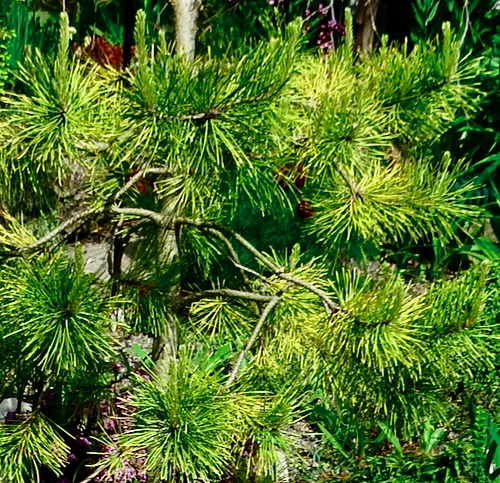
Pinus 'Chief Joseph' winter needles. Spring needles & candles.
Range: Pinus contorta is native to western North America.
Habitat: Inland mountain forests.
CULTIVATION:
Plant: ‘Chief Joseph’ will grow in a variety of soils, surviving in poor conditions, including city pollution and some drought.
Light: Full sun. It will die in full shade. I planted small specimen under an unwanted evergreen, thinking it would benefit from protection until it became established and the large evergreen was removed. The small 'Chief Joseph' was dying so I pouring water over it, resulting in its quick death.
Soil: Most soils, well drained.
Water: Dry to medium, drought tolerant. Intolerant of waterlogged soils.
USDA Hardiness: Zone 4 - 9
Companion planting: An accent plant. Grow with spring bulbs, rock garden plants.
Pruning: ‘Chief Joseph’ although classified as dwarf, can grow up to 15 cm per year, eventually forming a twisted narrow shape up to 6 m high and 180 cm wide. This is too big for my rock garden. I pinch back the candles by 2/3 in the spring when still soft and remove some branches to maintain an open shape.
Propagation: Try grafting a green needled cutting on Pinus contorta rootstock.
Problems: Do not plant in the shade. No major problems.
Alternative plants: Pinus mugo ‘Ophir’ or ‘Carstens’ are both yellow.
References:
Missouri Botanical Garden Plant Finder
https://www.gardenia.net/plant/pinus-contorta-chief-joseph
Text and images supplied by Anna Leggatt (Toronto Master Gardener)

Plant of the Month - January 2023
GENERAL INFORMATION: Hamamelis × intermedia cultivars are crosses between Japanese witch hazel (H. japonica) and Chinese witch hazel (H. mollis). These are wonderful additions to the winter garden with flower colours ranging from pale yellow to oranges and reds, with some creams. Our North American native forest understory small tree, H. virginiana, flowers earlier in the fall. It is wonderful walking underneath (or beside) and looking up at the yellow leaves illuminated by the sun, highlighting the yellow flowers. The seeds of all these ripen in the fall giving rise to the name - Hamamelis, Hama = same time, Melis = apple or fruit.
Synonym: H. x intermedia ‘Copper Beauty’.
Common Name: Witch Hazel.
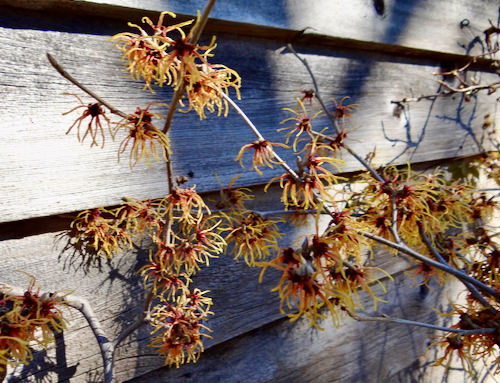
Hamamelis x intermedia 'Jelena'.
Life Cycle: Vase shaped deciduous Shrub.
Height: to 3-4 m, spreading to 3-4 m.
Bloom Time: Late December to March in Toronto.
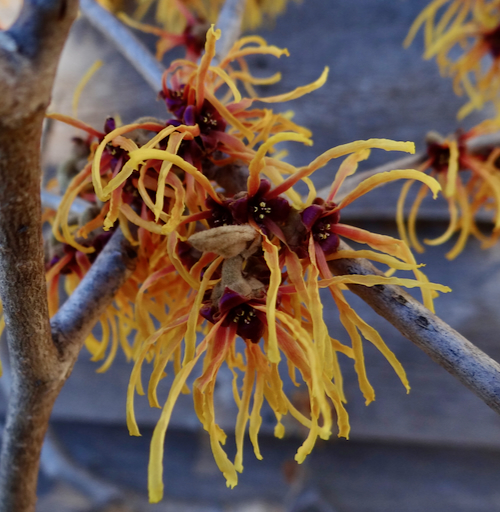
Hamamelis x intermedia 'Jelena' - close up.
Flower Colour & Size: The spidery flowers are about 2.5 cm long, consisting of four thin wavy petals, alternating with the pointed sepals of the purple red calyx. The petals appear copper coloured but have red bases, then orange with yellow tips at maturity. The younger tips are red. They curl up in cold weather, only to reproduce the display when the warmth returns. Unfortunately, my cultivar is unscented.
Hamamelis x intermedia 'Jelena' summer leaves and fall colour.
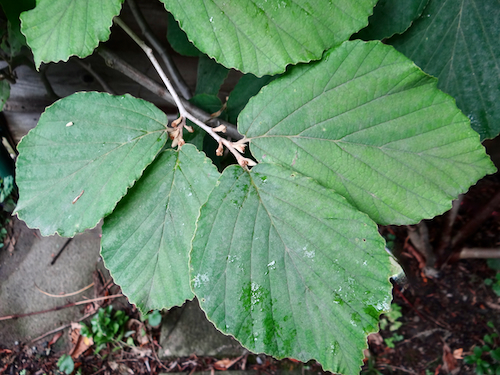
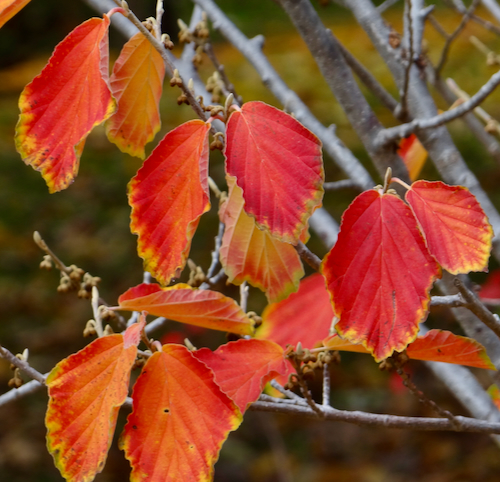
Leaves: The short petioled oval leaves are rough, about 10 cm long, with wavy, almost toothed margins. Fall colour is brilliant orange scarlet in full sun but mostly yellow in shade.
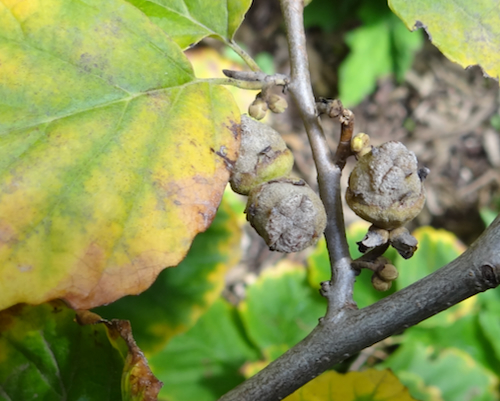
Hamamelis x intermedia 'Jelena' fruit.
Fruit: The seeds are in a green capsule becoming brown and woody by October. One or two hard black elliptical seeds are projected 2-3 m when the capsule splits open. To collect, harvest the almost ripe capsules and place in a mesh bag in the warm.
Range & Habitat: H. japonica grows in the mountains in Japan. H. mollis is from forests in southern China. It is the most fragrant of the species. Our native H. virginiana is a small understory tree in wooded ravines.
CULTIVATION:
Plant: where it can be seen from your home, preferably on the south side so the winter sun will shine through illuminating the flowers.
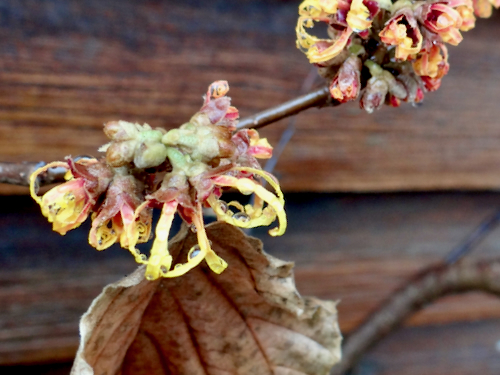
Hamamelis x intermedia 'Jelena' Dec 31.
Light: Full sun to part shade.
Soil: Preferably acid, organically rich, well drained soils. All my cultivars grow happily in alkaline soil.
Water: Constant moisture is best.
USDA Hardiness: Zone 5-8.
Pruning: This cultivar may become too large. Prune in the spring after flowering to shape the shrub and to control size. Remove non-flowering branch tips to improve appearance before the buds open.
Propagation: By Seed. It will differ from the hybrid parent. Use repeated cycles of 20°C, then 4°C for 3 months each. Germination is very prolonged.
Vegetative - Cuttings are difficult to overwinter. Grafting or budding will produce plants faster. Layering is possible if you want only one or two plants.
Companion planting: Hellebores, spring bulbs and woodland perennials.
Problems: Insect damage to leaves, powdery mildew. Watch for suckers from grafted root stock.
References:
https://www.missouribotanicalgarden.org/PlantFinder
Royal Horticultural Society Plant Collector Guide: Witch Hazels. Lane, Chris: Timber Press, 2005. ISBN 0-88192-678-7.
Text and images supplied by Anna Leggatt (Toronto Master Gardener)

Plant of the Month - December 2022
GENERAL INFORMATION:
We always had a Christmas Rose flower arrangement on our festive table in England when I was young. My Mother had previously surrounded the plant with an open box in the fall. This was covered with glass if the temperature dropped below freezing. We usually had flowers to bring inside.
A friend gave me a small division of Helleborus niger ‘Praecox’ over forty years ago. This was from a clone in Vancouver. It starts to bloom in our Toronto garden in the fall, sometimes in the 3rd week of October. I cover it so I can pick flowers if weather permits. It divides easily, sections more or less falling apart, unlike the other Helleborus niger plants I grow.
Common Name: Christmas Rose, Black Hellebore, St Agnes Rose.

Helleborus niger 'Praecox' - buds October 27, 2022.
Life Cycle: Herbaceous evergreen perennial.
Height: to 30 cm, spreading to 40 cm.
Bloom Time: Early November to April in Toronto.
Flower Colour & Size: Bowl shaped, 7 cm across, usually single flowered with 5 white, long lasting, petaloid, green based sepals, sometimes fading to pink. The petals are reduced to small green nectaries below numerous yellow stamens and 5 green capsules.
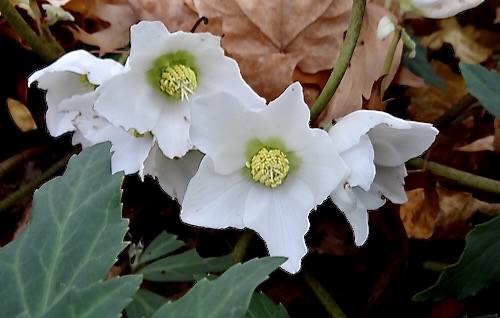
Helleborus niger 'Praecox' November 11 2022.
Leaves: Dark green, leathery compound leaves with 7-9 irregularly toothed, palmate leaflets.
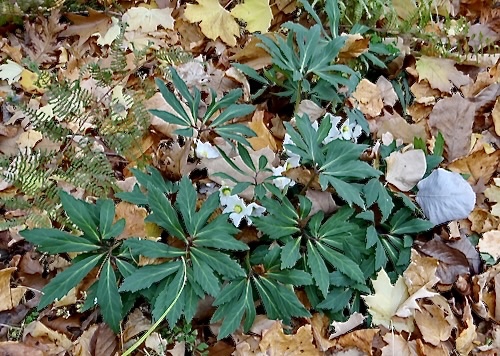
Helleborus niger 'Praecox' - leaves.
Range: Helleborus niger is native to Southern and Central Europe.
Habitat: It grows in alpine areas and montane woodlands.
CULTIVATION:
General Care: Cut back old leaves in spring when young leaves appear to prevent Hellebore Black Death (virus).
Plant: As a specimen, close to house, to enjoy bloom in winter.
Light: Semi-shade to full deciduous shade.
Soil: Neutral to alkaline, humus rich soils.
Water: Moist, well drained with medium amounts of water.
USDA Hardiness: Zone 3 - 8.
Companion planting: Spring bulbs, Hosta, ferns.
Propagation: Seed (if any - may be too cold for pollinators): fresh sown is best. Older seed requires soaking. Then use repeated cycles of 20°C, then 4°C for 3 months each. Germination is slow.
Divide carefully in spring.
Problems: Rot with winter wet. Slugs eat flowers. Black death of Hellebores.
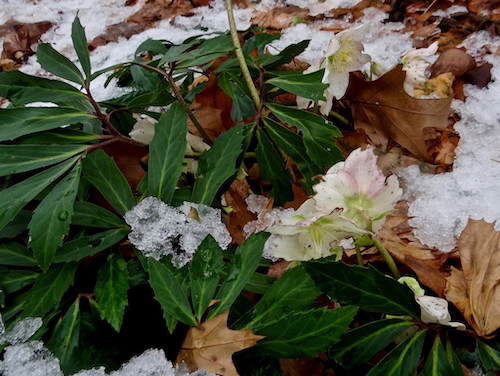
Helleborus niger 'Praecox' - winter damage.
References:
https://www.missouribotanicalgarden.org
Alpine Garden Society Encyclopedia of Alpines, Vol I.
Text and images supplied by Anna Leggatt (Toronto Master Gardener)

